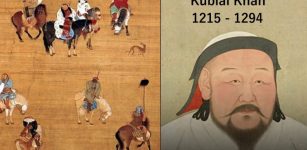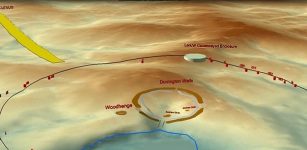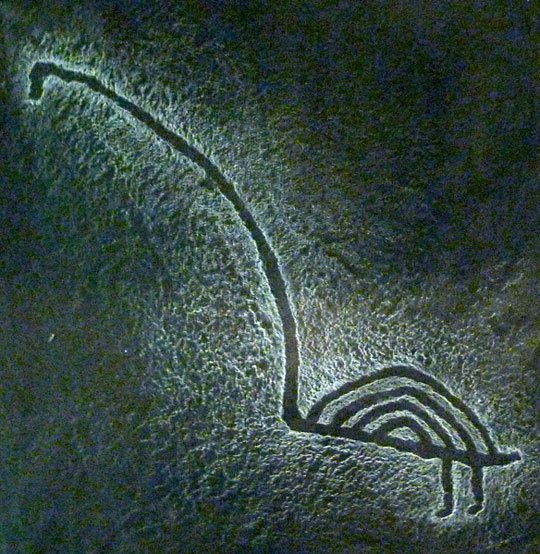Prehistoric ‘Cinema’ – Unique Karelian Rock Carvings With Special Light Effects
Ellen Lloyd - AncientPages.com - At first glance the Karelian rock carvings do not appear to be different from other carvings around the world. However, these petroglyphs are considered some of the most complex and expressive examples of rock art in northern Europe.
What is extraordinary about them is that they display special light effects. Watching some of the Karelian rock carvings is like viewing a movie in a prehistoric cinema.
A swan, from the Karelian Lake Onega region of Russia. Image credit: David Rothenberg.
The rock carvings show scenes our ancestors wanted to preserve for future generations. It's quite remarkable how much time and effort the ancients must have put into these stunning ancient creations.
On the eastern bank of, the second largest lake in Europe archaeologists discovered about 1,200 rock drawings that are estimated to be from 5 to 6 thousand years. Lake Onega is found in the Republic of Karelia, Russia.
Although the Karelian rock carvings have been known for more than a hundred years, it took a long time before scientists made an effort to interpret and analyze the individual motives.
“With knives only made of rough stone, the artists cut figures of men, animals, birds, fish, reptiles, lunar and solar symbols, all on hard granite.
These men must have had a clear idea of what they wanted to show, also acute vision and steady hands, since a wrong cut in the silica could have ruined the picture for good. Granite is a canvas that will not allow corrections.
The choice of site is also interesting since they picked on rocks rising vertically from the lake waters, “said Konstantin Lauskin, a Russian archaeologist.
Lake Onega
Why would our ancestors bother to carve images on difficult accessible hard rocks when it was much easier to construct the rock drawings in other places?
Was it because the ancients wished to create a prehistoric cinema for future generations? A study of the site indicates that the ancient artists were very familiar with various light effects.
“The designs on the cliffs become clearer in the sun’s rays at sunset, and it is clear that the artists chose them precisely because of the light-effects, not because of wishing to run risks,” explained Lauskin who had the luck to see some of the prehistoric drawings during the summer solstice.
“Before the sun went down the designs were confused, so that they could hardly be distinguished from below. But when the sun neared the horizon the granite shone dark-red and the variously colored lines of patterns were very clear.
This is a magnificent spectacle that can be scientifically explained.
Karelian carving depicting a giant figure.
“Granite has a granular structure which is easily polished. The Onega granite has been polished for thousands of years by the water while the lines of the carvings on the smooth surfaces of the rocks maintain the above-mentioned granular structure.
ding areas. Thus the incisions become alive, though the such luminous effects are not the only ones they have,” said Lauskin.
 Finn-Ugrick rock art from the Karelian Lake Onega region of Russia.Image credit: David Rothenberg.
Finn-Ugrick rock art from the Karelian Lake Onega region of Russia.Image credit: David Rothenberg.
When you look at the rock drawings they appear primitive and insignificant, but they will surprise you. The carved images become alive almost before the sun rays touch the rocks! The depiction of the frog seems to turn into an elk. The hunter makes a movement with the hand and the campfire flickers. The entire spectacle on the granite lasts for a quarter of an hour until the setting sun makes the designs grow weaker.
The images on the rocks are also moving, but there is a scientific explanation for this phenomenon.
“Think of some luminous signs: if the light goes on and off regularly the signs will seem to be moving. The same effects can be seen here – groups of tiny prisms on the unequal surfaces of the designs act like lamps so that in certain moments some will become more luminous than others. The intensity of the light reflected will thus be different, as certain parts will shine more than others.
Both light sources are moving and whilst the sun is setting the angle of incidence of its rays is constantly changing likewise; whereas the water plays the part of a reflector. The incidence of the rays makes the various groups of prisms shine which gives the onlooker the impression that the whole design is moving,” Lauskin explained.
The creation behind the Onega petroglyphs is the work of a group of intelligent people. Watching the carvings when the sun rays touch the rocks, is like watching a movie that has reached us from the late Stone Age. History is alive in Karelia and the ancient movie is still playing…
Written by - Ellen Lloyd – AncientPages.com
Copyright © AncientPages.com All rights reserved. This material may not be published, broadcast, rewritten or redistributed in whole or part without the express written permission of AncientPages.com
More From Ancient Pages
-
 Roman Leather Toy Mouse Found At Vindolanda
Archaeology | Jun 6, 2023
Roman Leather Toy Mouse Found At Vindolanda
Archaeology | Jun 6, 2023 -
 Huge Over 1,000-Year-Old Beautiful Stone Murals Discovered In Central China
Archaeology | Oct 14, 2022
Huge Over 1,000-Year-Old Beautiful Stone Murals Discovered In Central China
Archaeology | Oct 14, 2022 -
 Evidence Reveals Ancient Saudi Arabia Had A Complex, Thriving Society, Contradicting Notions Of A Struggling Population In Barren Lands
Featured Stories | Aug 21, 2024
Evidence Reveals Ancient Saudi Arabia Had A Complex, Thriving Society, Contradicting Notions Of A Struggling Population In Barren Lands
Featured Stories | Aug 21, 2024 -
 Rare Roman Mosaic Of Amazon Warriors Unearthed In Syria Hailed As Major Archaeological Discovery
Archaeology | Oct 12, 2022
Rare Roman Mosaic Of Amazon Warriors Unearthed In Syria Hailed As Major Archaeological Discovery
Archaeology | Oct 12, 2022 -
 Vikings And The Runic Calendar
Artifacts | Mar 4, 2016
Vikings And The Runic Calendar
Artifacts | Mar 4, 2016 -
 Beautiful And Unique Ancient Roman Hoard Discovered In UK
Archaeology | Oct 3, 2017
Beautiful And Unique Ancient Roman Hoard Discovered In UK
Archaeology | Oct 3, 2017 -
 Mirpur Jain Temple: Stunning Artwork Of Ancient Craftsmen Of India
Featured Stories | May 17, 2021
Mirpur Jain Temple: Stunning Artwork Of Ancient Craftsmen Of India
Featured Stories | May 17, 2021 -
 On This Day In History: One Of The Tallest Women In History – Died – On August 5, 1888
News | Aug 5, 2016
On This Day In History: One Of The Tallest Women In History – Died – On August 5, 1888
News | Aug 5, 2016 -
 Emperor Kublai Khan: One Of The Most Powerful People In Human History
Featured Stories | May 23, 2017
Emperor Kublai Khan: One Of The Most Powerful People In Human History
Featured Stories | May 23, 2017 -
 7,000-Year-Old Tepe Ozbaki Mounds Yielded Valuable Relics – But Now The Site Is In Trouble
Archaeology | Nov 25, 2020
7,000-Year-Old Tepe Ozbaki Mounds Yielded Valuable Relics – But Now The Site Is In Trouble
Archaeology | Nov 25, 2020 -
 Ice Age Mystery – Unexplained Disappearance Of North America’s Large Mammals – New Clues
Fossils | Jun 1, 2024
Ice Age Mystery – Unexplained Disappearance Of North America’s Large Mammals – New Clues
Fossils | Jun 1, 2024 -
 Outstanding Discovery Of Unique Swords From The Viking Age Near Gausel Queen’s Grave
Archaeology | Jun 3, 2022
Outstanding Discovery Of Unique Swords From The Viking Age Near Gausel Queen’s Grave
Archaeology | Jun 3, 2022 -
 Mysterious Viking Burial Site Of Three Women In Norway Reveals Its Secrets
Vikings | Dec 26, 2024
Mysterious Viking Burial Site Of Three Women In Norway Reveals Its Secrets
Vikings | Dec 26, 2024 -
 Oldest Fossil Human Footprints In North America Confirmed
Archaeology | Oct 6, 2023
Oldest Fossil Human Footprints In North America Confirmed
Archaeology | Oct 6, 2023 -
 Oldest Footprints In Europe Belonged To A Mysterious 950,000-Year-Old Ancestor
Archaeology | Jul 22, 2019
Oldest Footprints In Europe Belonged To A Mysterious 950,000-Year-Old Ancestor
Archaeology | Jul 22, 2019 -
 Elizabeth Woodville: Mother Of The Princes In The Tower And Commoner Queen
Featured Stories | Jul 16, 2018
Elizabeth Woodville: Mother Of The Princes In The Tower And Commoner Queen
Featured Stories | Jul 16, 2018 -
 Huge Ring Of Ancient Shafts Discovered Near Stonehenge
Archaeology | Jun 22, 2020
Huge Ring Of Ancient Shafts Discovered Near Stonehenge
Archaeology | Jun 22, 2020 -
 Unknown Prehistoric Henge Site Detected Near Famous Newgrange In Ireland’s East Coast
Archaeology | Jul 13, 2018
Unknown Prehistoric Henge Site Detected Near Famous Newgrange In Ireland’s East Coast
Archaeology | Jul 13, 2018 -
 The Main Gate Of Historical 9th-Century Old Harran Palace Unearthed
Archaeology | Oct 25, 2020
The Main Gate Of Historical 9th-Century Old Harran Palace Unearthed
Archaeology | Oct 25, 2020 -
 Skilled Nabataeans Celestially Aligned Petra’s Wonderful Architecture
Featured Stories | Mar 6, 2014
Skilled Nabataeans Celestially Aligned Petra’s Wonderful Architecture
Featured Stories | Mar 6, 2014



